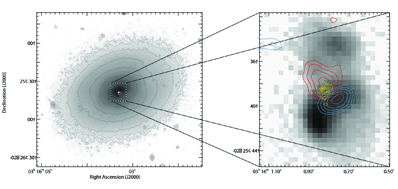


|

|
 |
|
Watching a galaxy blow itself to old age KEITH COOPER ASTRONOMY NOW Posted: 12 January 2011 A lenticular-shaped galaxy 100 million light years away is expelling all its star-forming molecular gas, setting itself up for an infertile future where it will form no more stars and become ‘red and dead’. Two types of disc galaxy inhabit the Universe: spiral galaxies like our Milky Way that have blue arms glowing with star formation, and dusty red discs, termed lenticular galaxies, where star formation has long since ceased and the only stars that remain are the old, cool, red stars. Until now, however, the link between the two – how a spiral evolves into a dusty red galaxy – has been a mystery.  On the left is a greyscale optical image of NGC 1266, but infrared and millimetre-wave observations of the galaxy’s inner regions reveal a dense disc of molecular gas that is being expelled from NGC 1266 at a tremendous rate. This outflow appears as two lobes, indicated by contour lines, in the zoomed-in image on the right. Click on the image to see a larger version. Image: Katherine Alatalo/UC Berkeley. Astronomers at the University of California, Berkeley took a closer look at the lenticular galaxy NGC 1266, a magnitude +14 object in the constellation of Eridanus, with the aid of data from the ATLAS3D (http://www-astro.physics.ox.ac.uk/atlas3d/) – a multi-telescope, multi-wavelength survey of 263 galaxies in a volume of space within 140 million light years. What they found was surprising: all the galaxy’s molecular hydrogen gas, which is the gas that can form stars, has wound up in a dense rotating disc 300 light years in diameter circling the core of the galaxy, where a supermassive black hole lurks. This disc of gas is 100 times more dense than a typical molecular cloud such as the Orion Nebula. Furthermore, this gas is being expelled by a powerful 400-kilometre per second outflow at a rate of 13 solar masses (the Sun’s mass is 1.98 x 1030 kilograms) per year. If the galaxy keeps up this current rate of outflow, NGC 1266 will have exhausted all its molecular gas within 85 million years, leaving it ‘red and dead’. However, the lack of a clear explanation for the outflow prevents astronomers from saying whether such behaviour happens to all galaxies evolving from blue spirals to red lenticulars, or whether this is a one-off case unique to NGC 1266. Despite intensive searching no companion galaxies that could forcibly eject the gas though tidal forces have been found. A intense area of star formation inside the inner disc could produce enough energy to drive the outflow, but there is no evidence of such a ‘starburst’ taking place in NGC 1266. “We find that we are seeing fewer stars form than we would expect,” says Katherine Alatalo, a graduate student at the University of California, Berkeley. “In particular, the gas in the inner disc should form about ten solar masses a year, but instead is forming at most three solar masses per year if we assume that all the far-infrared flux is coming from star formation, which is an unrealistic assumption in the presence of an active galactic nuclei. More realistically it is 1.5 solar masses per year using the more accurate 24 micron emission observed by the Spitzer Space Telescope.” Rather than star formation, jets from the supermassive black hole at the heart of NGC 1266 are the chief suspect. An active black hole is termed an active galactic nuclei, or AGN. “We don’t yet know if the AGN is powering the molecular winds directly or whether the molecular gas is entrained by narrow jets that that have yet to be observed,” says Professor Leo Blitz of the University of California, Berkeley. Jets such as those seen in M87 in Virgo can remain switched on long enough to drive out all the molecular gas. The research is to be published in the Astrophysical Journal;, and was presented at the 217th meeting of the American Astronomical Society, taking place this week in Seattle. Does the research imply a link between all AGN and red and dead galaxies? Possibly. “However,” cautions Blitz, “It would be best to first find a few more examples of NGC 1266-type galaxies and see whether their outflows are all powered by AGN.” |
|
|
|
|